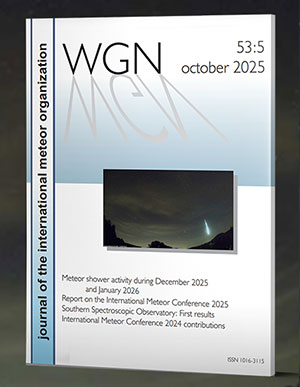Meteor rates continue to be strong as seen from
the northern hemisphere. The antihelion radiant has now merged with the two Taurid
radiants producing slow meteors during the late evening and early morning hours.
Meteors from the Orionid radiant are visible most of the month. Strong sporadic
rates continue during the morning hours as long as the moon is below the horizon.
From the southern hemisphere, sporadic rates have reached their nadir and begin
a slow recovery the second half of the month. Meteors from the Taurid and Orionid
radiants also help to fill the southern skies with more activity than has been seen
since July. A new moon during the peak of the Orionid shower is a plus for all and
should help inflate meteor totals that have suffered since the Perseid maximum
back in August.
This week the moon reaches its first quarter phase
on Sunday October 29. At this time the moon will set near midnight local standard
time (LST) and will not be a factor in observing during the busy morning hours.
The estimated total hourly rates for evening observers this week is near four for
those north of the equator and two for observers south of the equator. For morning
observers the estimated total hourly rates should be near thirty for northern
observers and twenty for those south of the equator. These rates assume that
you are watching from rural areas away from all sources of light pollution. The
actual rates will also depend on factors such as personal light and motion perception,
local weather conditions, alertness and experience in watching meteor activity.
The radiant positions listed below are exact for Saturday
night/Sunday morning October 28/29. These positions do not change greatly day to day
so the listed coordinates may be used during this entire period. Most star atlases
(available at science stores and planetariums) will provide maps with grid lines
of the celestial coordinates so that you may find out exactly where these positions
are located in the sky. A planisphere or computer planetarium program is also useful
in showing the sky at any time of night on any date of the year. Activity from each
radiant is best seen when it is positioned highest in the sky, either due north or
south along the meridian, depending on your latitude. Meteor activity is not seen
from radiants that are located below the horizon. The positions below are listed
in a west to east manner in order of right ascension (celestial longitude). The
positions listed first are located further west therefore are accessible earlier
in the night while those listed further down the list rise later in the night.
These showers are expected to be active this week:
At this time of year debris from comet 2P/Encke produces a double radiant very
close to the position of the antihelion radiant. From now through the end of
November, it is impossible to resolve the antihelion meteors from those produced
by comet 2P/Encke. Therefore we suggest that observers simply classify meteors
from this area as either north or south Taurids. Although the radiants actually
lie in Aries during October, they reach maximum activity in November when they
are situated in the constellation of Taurus.
The Northern Taurid (NTA) radiant is now centered at 03:04 (046) +20. This
position lies in eastern Aries, two degrees west of the fourth magnitude star
Delta Arietis. The Southern Taurid (STA) radiant lies at 03:04 (046) +14.
This position lies in southeastern Aries, five degrees southwest of Delta Arietis.
The two radiants are separated by slightly over five degrees. Since they have
the same right ascension (celestial longitude), it is difficult to distinguish
meteors that move north or south out of the radiants. It is slightly less difficult
to distinguish those meteors traveling east or west.
These radiants are above the horizon most of the night and are best placed near
midnight LST, when they lie on the meridian and are located highest in the sky. Rates
at this time should be near three per hour for the southern radiant and two per hour
for the northern radiant, regardless of your location. With an entry velocity near
30 km/sec., the average Taurid meteor would be of medium-slow speed.
The Orionids (ORI) put on a fantastic display this
past weekend. Rates were three times than what were expected. Rates are still above
normal at around 10-15 per hour. The radiant has now moved into the constellation of
Gemini and is located at 06:40 (100) +16. This position lies in southwestern Gemini,
at the spot occupied by the second magnitude star Alhena (Gamma Geminorum). The
radiant rises near 2100 LST and is best placed on the meridian near 0400. Rates
will slowly diminish as we move further away from the date of maximum activity.
At 64km/sec., the average Orionid is swift.
Sirko Molau’s study of video radiants has revealed
activity from the Gemini/Cancer border during the period October 27 through
November 4. Maximum occurs on October 31 with a radiant located at 07:44 (121)
+16. This position lies in western Cancer, three degrees southwest of the faint
star known as Zeta Cancri. This radiant is best placed on the meridian near 0500
LST. It appears that six percent of the total activity for the night is related
to this radiant. At 60km/sec., the average meteor from this radiant would be swift.
Sporadic rates have reached the late year plateau
for observers located in the northern hemisphere. One would expect to see perhaps
sixteen random meteors during the last hour before dawn from rural observing sites.
During the first dark hour after the end of evening twilight, perhaps four random
meteors can be seen per hour. Sporadic rates increase as the night progresses so
rates seen near midnight would be near ten per hour. Sporadic rates seen from
the southern hemisphere have passed their annual minimum and are rising again.
One would expect to see approximately five random meteors per hour during the
last hour before dawn and two per hour during the first dark hour after the end
of evening twilight. Rates near midnight would be near four per hour.
| SHOWER | DATE OF MAXIMUM ACTIVITY | CELESTIAL POSITION | ENTRY VELOCITY | CULMINATION | HOURLY RATE | CLASS* | RA (RA in Deg.) DEC | Km/Sec | Local Standard Time | North-South | Northern Taurid (NTA) | Nov 12 | 03:04 (046) +20 | 29 | 00:00 | 2 – 2 | II | Southern Taurid (STA) | Nov 5 | 03:04 (046) +14 | 27 | 00:00 | 3 – 3 | II | Orionids (ORI) | Oct 21 | 06:40 (100) +16 | 66 | 04:00 | 10 – 10 | I | Zeta Cancrids (ZCA) | Oct 31 | 07:44 (121) +16 | 60 | 05:00 | 2 – 2 | IV |
Clear Skies!




 You saw something bright and fast? Like a huge shooting star? Report it: it may be a fireball.
You saw something bright and fast? Like a huge shooting star? Report it: it may be a fireball.  You counted meteors last night? Share your results with us!
You counted meteors last night? Share your results with us!  You took a photo of a meteor or fireball? You have a screenshot of your cam? Share it with us!
You took a photo of a meteor or fireball? You have a screenshot of your cam? Share it with us!  You caught a meteor or fireball on video? Share your video with us!
You caught a meteor or fireball on video? Share your video with us!